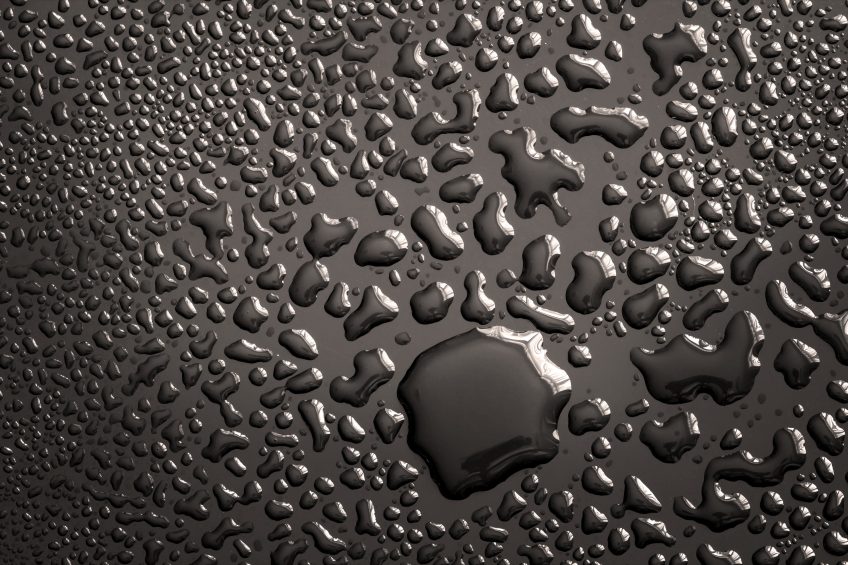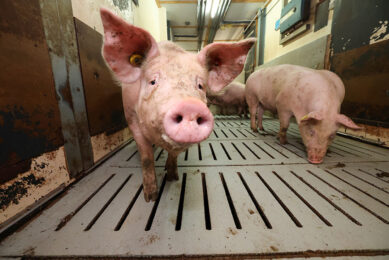11 steps for dealing with condensation in pig farms

Last month, pig management expert John Gadd pointed out that pigs can be quite wet animals, leading to a lot of condensation in pig houses. There is a simple way to solve problems of moist. Here’s how, in 11 steps.
Last time I outlined some information on what causes condensation. Of course as the experts correctly tell us, adequate insulation and correctly-set ventilation are the 2 essential starting points towards prevention. Both can take time, trouble and expense to get into order.
Eliminating damp spots quite cheaply
A look at the following alternative often eliminates damp spots and annoying drips quite cheaply as long as you know what to do. I have cured many such situations as follows:
1. The ‘Coandǎ effect’ occurs when an airflow travels across a smooth surface such as a ceiling. The energy from the airflow keeps it close to the ceiling surface until the air flow reduces sufficiently for gravity to take over, when it falls into the room space and dissipates. The principle was first defined by Romanian scientist Henri Coandǎ; the scientific definition reads: “The friction of a jet of air flowing along a smooth surface is less than the friction of the jet passing through the air.” Odd, but true! The air seems to slide across the ceiling defying gravity as long as the surface is reasonably smooth, as most underdrawn ceilings are.
2. There can be damp patches in some parts of the ceiling and upper walls such as in ‘stale’ corners where there is little or no air movement to help keep these areas dry.
3. We can use the Coandǎ effect to deflect some air into these places and remove the dampness and prevent it from forming again.
4. Understand how it works. Imagine a ceiling turned upside down. It then becomes a flat, horizontal surface. A floor in other words.
5. If you squirt water from a hosepipe across this floor it will continue until the water pressure falls sufficiently, when it will stop. Obvious!
6. Imagine that you need to deflect the flow of water to one place on the floor, say a drain. You could place a simple barrier to move some or all of the flow of water to the position targeted. Again obvious. The Coandǎ principle does exactly the same thing but upside down on the ceiling using air flow, not the flow of water.
7. The Coandǎ effect influences the flow of air across the ceiling in the same way as gravity did to the flow of water on the floor surface. Using a deflector or deflectors directs the flows in both circumstances – water on the floor; air on the ceiling.
8. What sort of ceiling airflow deflector? If you nail a thin length of wood of sufficient length and height to the ceiling to move some of the room’s Coandǎ airflow progressing across the ceiling towards the damp area to be ventilated, then the dampness will be removed. It may take a little time but it will disappear. A cheap and simple solution. Permanent, too.
9. Only a continuous gentle airflow is needed over the damp areas to help eliminate them. About 0.1 m/sec or 10 seconds to cross one metre. I find a triangular wooden batten or battens 300 mm broad x 300 mm tall to be adequate, nailed to the purlins supporting the ceilings, so as to act as a deflector. You are not using any more ventilation – just directing some of it to where it is needed.
Also read last month’s blog on condensation – John Gadd explained why pigs are wet animals
10. But where to place it? Use a chemical smoke puffer-tube or beekeeper’s smoker to see where the airflow is going. (Very few farms I visit have such things – a bad failing as they are so useful. Not only do they let you get things right but they teach you about how air moves in a piggery). Get an assistant to help you move the deflector to the correct position as you puff the smoke. Mark the position and then nail on the batten.
11. But what if the airflow stops before reaching the area to be gently ‘scoured’? Either increase the speed of the nearest fan, or what I find useful, hang what I call a ‘table top’ baffle-board angled to catch some of the incoming air towards the area concerned, when the strip deflectors take over to remove the dead spots. Baffle boards do gather dust though and need brushing down. Wear a mask!
Airflow running across the ceiling
My ‘upside down floor’ analogy may seem silly, but many stockpersons who often have the job of fixing the directional battens just cannot accept that airflow will run across the ceiling in the same way that water does over a floor, and that gravity must quickly dislodge it.
When I show them the Coandǎ effect with my own smoker, it surprises most of them and amazes a few! The moral of the story is: all farms should use some sort of smoking device – a valuable training tool, if nothing else.











